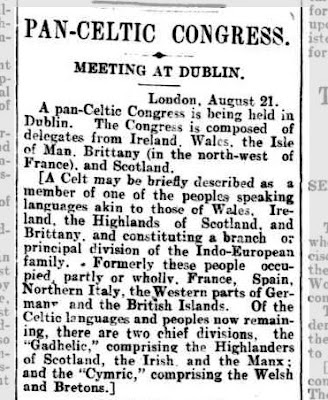Lia Ceneil - The Stone of the Nations.
A kilometre or so from Ballacolla in Laois lies Killermogh Church of Ireland. It is here that I inadvertently stumbled across an obscure and little known piece of Irish history, the Lia Ceneil or Stone of the Nations.
Begining in the late 19th century there occured what is often termed a "Celtic revival." It was a period of renewed interest in all things Celtic including art, literature, music, theatre, dance and language.
This coincided with a Gaelic revival and fresh interest in the Irish language and traditions. Irelands first President to be, Douglas Hyde, formed the Gaelic League Conradh na Gaeilge in 1893 along with with Eoin MacNeill.
Alongside all of this renewed activity centered on language and custom the "Irish Literary Revival" sprang up and was a movement of writers, poets and others interested in promoting literature and Irish politics.
The Gaelic Athletic Association had earlier been founded in 1884 in Thurles to promote Irish games such as hurling, football, handball and rounders.
All of these developments concerning language, custom, sport, music and writing culminated in a short period between the late 19th and early 20th century.
This turbulent period of Irish history also saw a resurgent republican movement, the 1916 rising and ultimately the War of Independence beginning at Soloheadbeg in Tipperary in 1919.
Douglas Hyde occasionally worshipped at Killermogh and it is his friend, Bernard Edward Barnaby Fitzpatrick, the second and final Baron Castletown, who is responsible for the Stone of Nations being sited at Killermogh.
Fitzpatrick founded The Celtic Association in 1900 and became its President.
The Celtic Association was a "Pan-Celtic" effort which included representation from five "Celtic Nations" - Ireland, Scotland, Wales, The Isle of Man and Brittany. A sixth was included later, Cornwall in England.
The Association held a Pan-Celtic Congress on three occasions, the first in 1901 at Dublin, followed by Caernafon at Wales in 1904 and the final Congress occured at Edinburgh, Scotland in 1907.
The Lia Ceneil - The Stone of the Nations is composed of five seperate stones, one stone representing each "Nation" and laid atop one another in an upright column.
It appears from the newspaper reports of the times that a delegate from each Celtic "Nation" would place a stone in position until the column was completed and assembled at the site of Congress.
There are reports of bards, druids, ovates and archdruids at the Congress and it is known that the Celtic Association was held in disregard by some organisations and individuals.
The fact that both the Celtic Association and the Stone of the Nations remain hidden behind a veil of obscurity suggests that Bernard Fitzpatricks attempts at uniting different celtic traditions and people under a single Pan-Celtic banner ran its course and fizzled out.
Fitzpatrick was variously a Baron, an M.P. for Portarlington, a High Sheriff of Queen's County and a Lieutenant Colonel in the British Army who served in the Boer War.
The Celtic and Gaelic revivals were an effort to revive forgotten and lost customs and language and forge a seperate unique identity for Ireland. An identity free from any English influence or Anglo-Norman and Saxon association.
Occasionally there are important early Saxon influences which are overlooked or forgotten about because of a preoccupation with "Celtism."
Rarely will you hear of Willibrod or Berrihert, both early Anglo-Saxon Saints associated with Ireland but that's a thread for another day.
By all accounts Fitzpatrick seemed a decent fellow however his background would hardly have endeared him or the Celtic Association with Home Rule enthusiasts or Nationalists.
Although his friend Douglas Hyde's Gaelic League was a neutral and non denominational organisation at the outset which appealed to many and was interested chiefly in the promotion of the Irish language, Hyde eventually resigned as President because he believed the organisation became politicized.
Seperately Bernard Fitzpatrick's Celtic Association was always going to struggle to attract mainstream Irish participation despite its secular outlook.
This is probably especially so in light of the burdgeoning independence movement of the time. Druids and archdruids may well have been superfluous to and indeed counterproductive to the needs of groups such as Clan na Gael or the Irish Republican Brotherhood who had little immediate interest in Cornish celtic rituals or Breton dress codes.
The Lia Ceneil was moved from Grantstown Manor to Killermogh. The Second Baron Castletown lived a very interesting life and there is a wealth of information about him and the Fitzpatrick connections to the area to be found both in print and online.
It's been hard to follow the trail of the Celtic Association. For a time they published :
Celtia - A Pan-Celtic Monthly Magazine.
The Lia Ceneil - The Stone of the Nations,
Killermogh, Co-ordinates :
52°52'19.2"N 7°27'28.6"W
52.871994 - 7.457951
- Footnote -
Bernard Edward Barnaby Fitzpatrick, Baron Castletown, is a descendant of Barnaby Fitzpatrick, the 2nd Baron of Upper Ossory, who was a good friend and "Whipping Boy" of King Edward VI.
Barnaby Fitzpatrick was instrumental in the killing of Rory Oge O'More in 1578. Rory was sometimes alluded to as the "Robin Hood" of Ireland. I believe he was killed while hatching a plot to kidnap Barnaby. Rory was the archetypal rebel, a continual thorn in the side of the English Crown by all accounts.
Notice in the West Australian Newspaper 23rd Aug/1901
Clip from a report on the committee meeting - May 1899.
Craobh ná hÉireann den Chomhdháil Cheilteach










